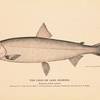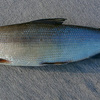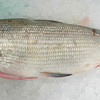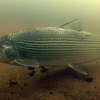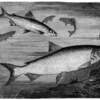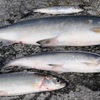Whitefish flyfishing
Whitefish flyfishing in the lake:
In the lakes, the food is often found in the shallows. Under normal conditions it is better to fish for whitefish in areas of sandy shallows, standing downwind. You can easily notice slight circles on the water, created by the slow movement of flocks of whitefish along the shore. Under such circumstances it is reasonable to use baits, which imitate the gammarus and mayfly nymph. The preferred colour range is from grey to dark brown and preferred hook sizes are: № 2.5 to № 4 (Local Russian numbering).
The line should be thrown along the shore line, rather than perpendicular to it and should be slightly pulled. At the same time the rod must be inline with the line. If the nymph is heavy it would be reasonable to have short pauses. The bait should be pulled in short jerks. The bite can be felt as change in the line’s weight or as a jerk. The fish should be hooked with the same hand in which you have the line.
The catch is rich during the massive overflight of mayflies. During such periods the whole population of the lake gathers in the rocky shallows with depths of up to 2 meters. The water surface is covered with waves and streaks made by the dorsal fins – this is when the whitefish, kumzha and grayling start to prey on mayfly larvae floating on the surface. At such time the recommended method of fishing is quite different. Since there is a chance of hooking in larger fish, the fly must be attached to a № 4-5 hook. You should start with a “wet” fly like “Woolly Worm”. After striking the first fish, you should gut it to see the kind of insect in the stomach to be able select the proper bait. The artificial bait must not be very different in size and colour from the real one. The line should be thrown perpendicular to the shore, as far out as possible and the fly should be drawn at a faster pace. Since the bait is quite big, the water resistance drags it out of water and it moves, creating kind of a trace on the surface, which makes it possible to track its movements from a considerable distance. The taking of bait is noticed visually.
Whitefish angling in the river
There is always a large or considerably smaller concentration of white fish in areas of sudden broadening of the rover. You can see flocks of whitefish in rapid waters, in calmer spots and near the banks. Usually the larger fish remain in calmer waters near the bottom. In such places you better use weighted nymph on hooks № 2.5-3.5. The line must be thrown in such a way as to let the nymph go as deep as possible. The fish normally bites, when the line straightens and the current starts to raise the nymph to the top levels. The dry fly is also very effective, but the larger fish very seldom surface or come close to surface or to areas with no current. But you can easily fish out 300-400 gram specimen using a dry fly, which looks like a mayfly.
The whitefish groups at the end of the expanse, entering the riffle, during the mass flight of insects. The water current flushes lots of mayflies from the lake, which tend to concentrate in the narrow areas. In these areas you can find many large whitefish, where the strong current disturbs them and they jump to the bait in fury.
However, such areas are always shallow and it is hard to approach the fish without scaring them off. You fish standing inside the water body and cast your line upstream, as far as you can, at a slight angle along the flow. It is better to start with a weighted nymph with hooks № 4.5-5 of darker colours. About a meter and a half from the nymph you attach a small strike indicator, made of cellular materials and dress it with synthetic fibres. After casting you readily start drawing the line coming towards the fisherman to avoid creating a jam near the rod’s end and you watch the strike indicator. When the fish bites the indicator disappears right away.
And now few tips in the end. The best fishing technique is the one which allows you to control the position of the fish as per the fly. It gives you some extra time to pull the line. This is an important factor, because the whitefish, unlike the kumzha, would throw out the bait very quickly.
The whitefish is not scared easily and you do not need to observe any special requirement to approach it, especially if the spot where you are fishing is significantly deep. But anyhow, when you are near the shallows, you should avoid wearing very bright clothing and should avoid abrupt rod movements.
When the fish is hooked, you should not hurry dragging it out, because I this case the hooked fish starts tumbling on the surface, which scares off the rest of the whitefish. However, you should not delay also, because the whitefish has dry, weak lips and can easily break off the hook. When fishing from the shore, it is wise to have a scoop net handy. Whitefish rots very quickly, therefore it is better to gut it straight away.
For whitefish angling you need class 5-6 rods of lengths up to 2.7 m. the line should be floating, double reel of class 5 and 5X leash. When fishing in the lake with nymph, you can use slow drowning line or submerging knotted leash. If you need to use relatively larger nymphs and wet flies on № 5 hooks or greater, you might use a thicker leash.

